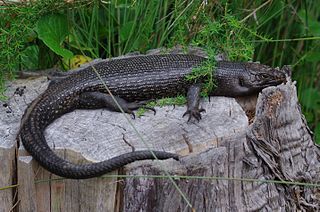
Skinks are lizards belonging to the family Scincidae, a family in the infraorder Scincomorpha. With more than 1,500 described species across 100 different taxonomic genera, the family Scincidae is one of the most diverse families of lizards. Skinks are characterized by their smaller legs in comparison to typical lizards and are found in different habitats except arctic and subarctic regions.

Scincella is a genus of lizards in the skink family, Scincidae, commonly referred to as ground skinks. The exact number of species in the genus is unclear, as taxonomic reclassification is ongoing, and sources vary widely. Scincella species primarily range throughout the temperate regions of the world and are typically small, fossorial lizards, which consume a wide variety of arthropods. They are a generalized insectivore with well developed chemosensory abilities.

Eumeces schneiderii, commonly known as Schneider's skink, is a species of lizard in the family Scincidae. The species is endemic to Central Asia, Western Asia, and North Africa. There are five recognized subspecies.
Vosmer's writhing skink is a species of skink, a lizard in the family Scincidae. The species is endemic to India.

Kaestlea travancorica, also known as the Travancore ground skink or Barbour's ground skink, is a species of skink endemic to southern Western Ghats.

Scincella lateralis, formerly Lygosoma laterale is a small species of skink found throughout much of the eastern half of the United States, and into northern Mexico. The ground skink differs from the majority of North American lizard species in that it is generally considered a forest dweller. Common names for this species include the little brown skink and the ground skink. However, the common name, ground skink, may refer to any species in the genus Scincella.
Ablepharus sikimmensis is a species of skink found in Bangladesh (Rangpur), Bhutan, China (Tibet), India and Nepal.

John Reeves was an English naturalist. He developed a notable collection of Chinese drawings of animals and plants. Reeves commissioned local Chinese artists to create the drawings, which are among the first examples of Chinese art done in the western style of scientific botanical and zoological illustration. Reeves was the son of Reverend Jonathan Reeves of West Ham, Essex. Orphaned young, he was educated at Christ's Hospital and started working with a tea merchant. His knowledge of teas got him an appointment of inspector of tea in 1808. In 1812 he was sent to China in the employment of the British East India Company. He was responsible for the introduction of a number of garden plants to the West including Wisteria. Reeves was a correspondent of the Horticultural Society of London to which he sent specimens. He also corresponded with Sir Joseph Banks, regularly sending him specimens. Reeves also took an interest in Chinese astronomy and herbal medicine, collaborating on these with the missionary and sinologist Robert Morrison. Reeves' son John Russell Reeves joined the tea business in 1827 and also took an interest in natural history and like his father, he too was elected into the Linnean and Royal Societies. Reeves senior returned to live in Clapham in 1831. He had sent specimens of the caterpillar fungus to Britain.

King's skink is a species of skink, a lizard in the family Scincidae. The species is endemic to Australia.

The banded supple skink, also known commonly as Harold's writhing skink and Harold Young's supple skink, is a species of lizard in the family Scincidae. The species is endemic to Southeast Asia.

Scincella gemmingeri, commonly known as the forest ground skink, Cope's forest ground skink, and la escíncela de bosque de Cope in Mexican Spanish, is a species of lizard in the family Scincidae. The species is endemic to Mexico.

Scincella vandenburghi, also known commonly as the Korean skink, the Tsushima ground skink, and the Tsushima smooth skink, is a species of skink, a lizard in the family Scincidae. The species is endemic to East Asia

Scincella barbouri, also known commonly as Barbour's ground skink, is a species of lizard in the family Scincidae. The species is endemic to China.
Scincella boettgeri, Boettger's ground skink, is a species of lizard in the family Scincidae. The species is native to the Ryukyu Islands of Japan.

Scincella caudaequinae, commonly known as the Horsetail Falls ground skink, is a species of reptile in the family Scincidae that is endemic to Mexico. It was named for the type locality "Horsetail Falls, 25 miles south of Monterrey, Nuevo, Leon". Scincella caudaequinae occurs in the northern Sierra Madre Oriental in Nuevo Leon, San Luis Potosi, southeast Coahuila, and Tamaulipas. It was considered a subspecies of Scincella silvicola for many decades.

Scincella cherriei, commonly known as the brown forest skink and Cope's brown forest skink, is a species of lizard in the family Scincidae. The species is native to Central America and adjacent southeastern Mexico. Three subspecies are recognized.
Scincella doriae, also known commonly as Doria's ground skink and Doria's smooth skink, is a species of lizard in the family Scincidae. The species is native to Southeast Asia.
Scincella forbesorum, also known commonly as Forbes' forest ground skink and la escíncela de bosque de Forbes in Mexican Spanish, is a species of lizard in the family Scincidae. The species is endemic to Mexico.












